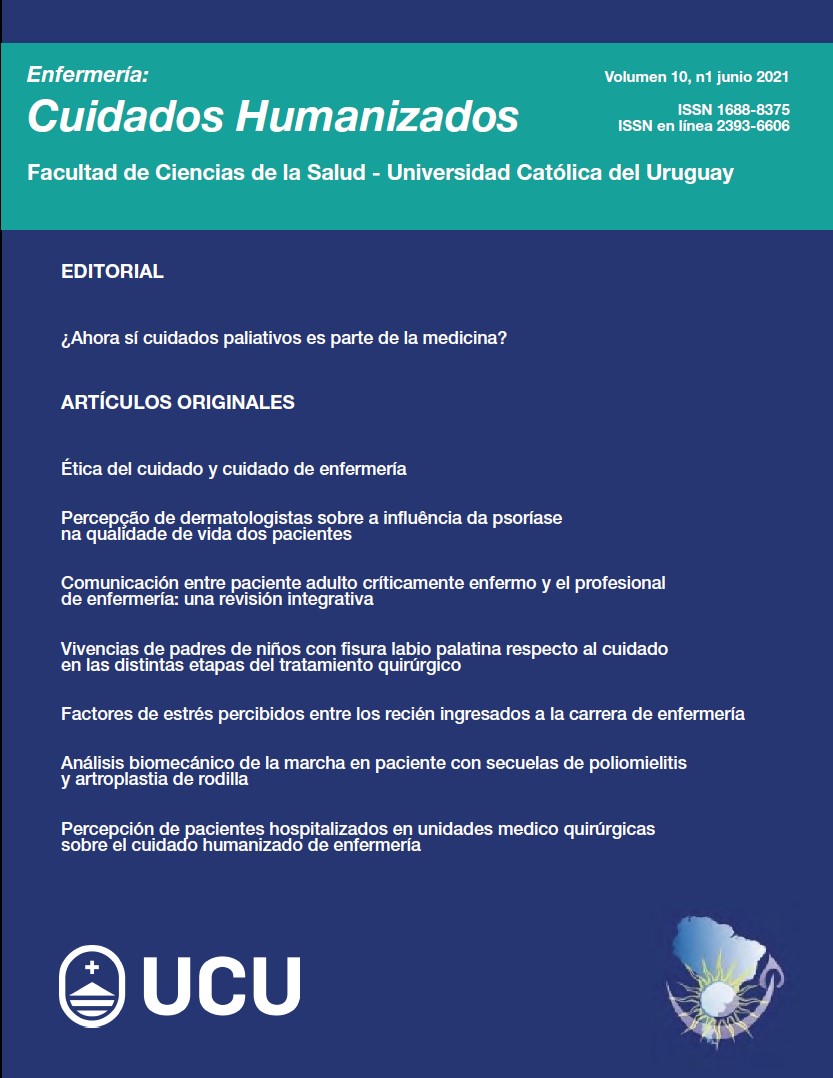Clinical gait analysis in patient with poliomyelitis sequelae and total knee arthroplasty
DOI:
https://doi.org/10.22235/ech.v10i1.2359Keywords:
Postpoliomyelitis syndrome, arthroplasty replacement knee, gait analysis, biomechanical phenomenaAbstract
Poliomyelitis is a disease that may cause irreversible sequelae, generating muscle strength deficits, flaccid paralysis and hyporeflexia, among others. Even though poliovirus infections are under control, people with sequelae that can affect their quality of life and everyday functions such as walking, are still being treated. When these sequelae affect the morphology and functionality of the knee joint, and every other conservative option has been exhausted, the total knee arthroplasty (TKA) is one of the most common surgical interventions. The main goal of the present study is to perform an instrumented gait analysis test of a patient with poliomyelitis sequelae and TKA, in order to define the best rehabilitation strategy and achieve the highest level possible of the patient’s function. 3D Gait Analysis was performed with an 8-camera motion capture system and reflective markers placed on specific body landmarks. Results show gait pattern disturbances in every joint and at every anatomical plane, being the most relevant the right hip internal rotation and a fixed 9 degrees ipsilateral knee flexion during the first half of the gait cycle. The analysis suggests that the patient adopts strategies that promote the activation of the tensor fascia lata as hip flexor and knee stabilizer at the maximum available extension (9 ° of flexion) replacing the weakened quadriceps muscle due to the poliomyelitis sequelae.
Downloads
References
Patterson BM, Insall JN. Surgical management of gonarthrosis patients with poliomyelitis. J Arthroplasty. 1992; 7(Suppl.): 419-426.
Giori NJ, Lewallen DG. Total knee arthroplasty in limbs affected by poliomyelitis. J Bone Joint Surg. 2002; 84(7): 1157-1161.
Perry J, Burnfield JM. Gait Analysis: Normal and Pathological Function. 2ª ed. New Jersey: Slack Incorporated; 2010.
Organización Mundial de la Salud. Notificados a la OMS el 1 de marzo de 2019. Poliomielitis [Internet]. Ginebra: OMS; 2020 [consultado 24 oct 2020]. Disponible en: https://www.who.int/es/news-room/fact-sheets/detail/poliomielitis.
Rahman J, Hanna SA, Kayani B, Miles J, Pollock RC, Skinner JA, et al. Custom rotating hinge total knee arthroplasty in patients with poliomyelitis affected limbs. Int Orthop. 2015; 39(5): 833-838.
Jordan L, Kligman M, Sculco TP. Total knee arthroplasty in patients with poliomyelitis. J Arthroplasty 2007; 22(4): 543-548.
Tigani D, Fosco M, Amendola L, Boriani L. Total knee arthroplasty in patients with poliomyelitis. Knee. 2009; 16(6): 501-506.
Prasad A, Donovan R, Ramachandran M, Dawson-Bowling S, Milington S, Bhumbra Rej, et al. Outcome of total knee arthroplasty in patients with poliomyelitis: A systematic review. EFORT Open Rev. 2018; 3(6): 358-362.
Dauwe J, Vandenneucker H. Indications for primary rotating-hinge total knee arthroplasty. Is there consensus? Acta Orthop Belg. 2018; 84(3): 245-250.
Partezani C, Nogueira P, Maftoum C, Gomes R, Kawamura M, Luis G. Knee arthroplasty with rotating -hinge implant: an option for complex primary cases and revisions. Rev Bras Ortop. 2018: 53(2); 151-157.
Yang JH, Yoon JR, Oh CH, Kim TS. Primary total knee arthroplasty using rotating-hinge prosthesis in severely affected knees. Knee Surg Sports Traumatol Arthrosc. 2012: 20(3); 517-523.
Kirschberg J, Goralski S, Layher F, Sander K, Matziolis G. Normalized gait analysis parameters are closely related to patient-reported outcome measures after total knee arthroplasty. Arch Orthop Trauma Surg. 2018; 138(5): 711-717.
Dominguez F, Igual C, Silvestre A, Roig S, Blasco JM. Effects of balance and proprioceptive training on total hip and Knee replacement rehabilitation: A systematic review and meta-analysis. Gait Posture. 2018; 62: 68-74.
Kendall FP, McCreary EK. Kendall’s músculos: Pruebas funcionales, postura y dolor. 5a. ed. Madrid: Marbán; 2007.
Taboadela C. Goniometría: una herramienta para la evaluación de las discapacidades laborales. 1a ed. Buenos Aires: Asociart ART; 2007.
Davis RB, Ounpuu S, Tyburski D GJ. A gait analysis data collection and reduction technique. Hum Mov Sci. 1991; 10: 575-587.
Kadaba MP, Ramakrishnan HK . Measurement of Lower Extremity Kinematics During Level Walking. J Orthop Res. 1990; 8: 383-892.
McGinley JL, Baker R, Wolfe R, Morris ME. The reliability of three-dimensional kinematic gait measurements: A systematic review. Gait Posture. 2009; 29(3): 360-369.
Baker R. Gait analysis methods in rehabilitation. J Neuroeng Rehabil. 2006; 3: 1-10.
Cappozzo A, Catani F, Della Croce AL. Position and orientation in space of bones during movement: anatomical frame definition and determination. Clin Biomech. 1995; 10(4): 171-178.
Collins TD, Ghoussayni SN, Ewins DJ, Kent JA. A six degrees-of-freedom marker set for gait analysis: Repeatability and comparison with a modified Helen Hayes set. Gait Posture. 2009; 30(2): 173-180.
Schwartz MH, Rozumalski A. A new method for estimating joint parameters from motion data. J Biomech. 2005 Jan; 38(1): 107-116.
Ehrig RM, Taylor WR, Duda GN, Heller MO. A survey of formal methods for determining the centre of rotation of ball joints. J Biomech [Internet]. 2006; 39(15): 2798-2809. Disponible en: http://www.ncbi.nlm.nih.gov/pubmed/16293257
Camomilla V, Cereatti A, Vannozzi G, Cappozzo A. An optimized protocol for hip joint centre determination using the functional method. J Biomech. 2006; 39(6): 1096-1106.
Ehrig RM, Taylor WR, Duda GN, Heller MO. A survey of formal methods for determining functional joint axes. J Biomech [Internet]. 2007; 40(10): 2150-2157. Disponible en: http://www.ncbi.nlm.nih.gov/pubmed/17169365
Portnoy S, Schwartz I. Gait characteristics of post-poliomyelitis patients: Standardization of quantitative data reporting. Ann Phys Rehabil Med. 2013; 56(7-8): 527-541.
Brogardh C, Flansbjer VB, Lexell J. Determinants of falls and fear of falling in ambulatory persons with late effects of polio. PM R. 2017; 9(5): 455-463.
Simonsen E, Cappelen K, Skorini R, Larsen P, Alkjær T, Dyhre-Poulsen P. Explanations pertaining to the hip joint flexor moment during the stance phase of human walking. J Appl Biomech. 2012; 28(5): 542-550.
Trammell AP, Nahian A, Pilson H. Anatomy, Bony Pelvis and Lower Limb, Tensor Fasciae Latae Muscle [citado May 7 2020]. En: StatPearls [Internet]. Disponible en: https://www.ncbi.nlm.nih.gov/books/NBK499870/
Kapandji A. Fisiología articular: Miembro inferior. Tomo 2. 1ª ed. Madrid: Panamericana; 2012.
Elkarif V, Kandel L, Rand D, Schwartz I, Greenberg A, Portnoy S. Muscle activity while ambulating on stairs and slopes: A comparison between individuals scheduled and not scheduled for knee arthroplasty and healthy controls. Musculoskeletal Science and Practice. 2021; 52: 102346.
Bianchi N, Facchini A, Mondanelli N, Sacchetti F, Ghezzi R, Gesi M, Capanna R, Giannotti S. Medial pivot vs posterior stabilized total knee arthroplasty designs: a gait analysis study. Med Glas (Zenica). 2021 Feb 1; 18(1): 252-259.
Yoshida Y, Mizner RL, Snyder-Mackler L. Association between long-term quadriceps weakness and early walking muscle co-contraction after total knee arthroplasty. Knee. 2013; 20(6): 426-431.
Marmon AR, Snyder- Mackler L. Activation deficits do not limit quadriceps strength training gains in patients after total knee arthroplasty. Int J Sports Phys Ther. 2014; 9(3): 329-337.
Downloads
Published
How to Cite
Issue
Section
License
Copyright (c) 2021 Enfermería: Cuidados Humanizados

This work is licensed under a Creative Commons Attribution 4.0 International License.

















